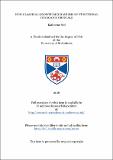Non-classical growth mechanisms of functional inorganic crystals
Abstract
This project relates to the non-classical growth of inorganic crystals with interesting morphologies that are highly desirable in industry. All crystals were synthesized via hydrothermal or solvothermal methods and their growth was studied by stopping each reaction at a range of different times, extracting the particles and analysing them using a variety of characterisation techniques. The main techniques used were scanning electron microscopy and transmission electron microscopy but other techniques, such as powder X-ray diffraction and thermal gravimetric analysis, were also employed.
Decorated ZnO microstadiums were studied where ZnO nanocones coat the inner and outer columnar walls of ZnO microstadiums. It was revealed that the polymer in the synthetic solution enhanced the aggregation of nanocrystallites of precursor ions on the microstadium surfaces, which then underwent recrystallization, forming ZnO nanocones. The presence of organic agents was also found to be crucial in the non-classical growth mechanisms of CaCO₃ and RHO-ZIF crystals as the presence of charged groups on the organic molecules led to the aggregation of precursor molecules/ions, preventing classical growth. The disordered aggregates underwent surface recrystallization, forming ‘core-shell’ structures where a thin layer of single crystal encased a disordered core. Over time the crystallisation extended from the surface inwards, towards the core, until true single crystals were formed.
Organic molecules were also shown to play a role in the non-classical growth of 8-branched Cu₂O structures. In this case, however, studies of the electronic configuration of the main terminating facets of Cu₂O crystals revealed another key factor in their non-classical growth. Terminating hydroxyl groups on the Cu₂O surfaces could have different charges depending on the number of Cu⁺ ions they were coordinated to. The terminating {111} faces were the only ones to be coated with negatively charged hydroxyl groups, which explained the rapid growth on these surfaces as they were able to attract the positively charged metal/polymer precursor clusters. This new phenomenon was also found to be the main driving force in the rapid growth of branches in snowflake-like Fe₂O₃ crystals despite no organic agent being used. In this case, the {11-20} faces of the seed crystals had positively charged hydroxyl groups that were able to rapidly attract the negatively charged [Fe(CN) ₆]³⁻ ions in the aqueous solution.
Type
Thesis, PhD Doctor of Philosophy
Collections
Description of related resources
K. Self et al., CrystEngComm, 2013, 14, 10266. DOI: 10.1039/c3ce41543kK. Self et al., Chem. Eur. J., 2015, 21, 19090. DOI: 10.1002/chem.201503437
Items in the St Andrews Research Repository are protected by copyright, with all rights reserved, unless otherwise indicated.

